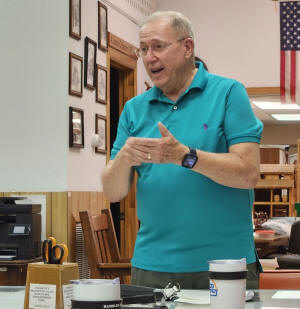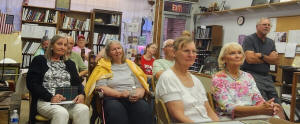|



As Dodson began his presentation, he quizzed everyone
about their knowledge of related Illinois history.
The first question Dodson asked was what the original name of
Springfield, Illinois was and where the name came from.
A person from Springfield was able to tell Dodson it was once called
Calhoun. Dodson said the name came from John Calhoun, a U.S. Senator
and Vice President.
Next, Dodson asked how many people in attendance read the Elkhart
newsletter and have heard of Edwards Trace. The recent Elkhart
newsletter shared information about Edwards Trace, which was once
the original highway from Kaskaskia all the way to Peoria.
Elkhart said they are the only place in the state of Illinois that
still has part of the Trace in their area, but Dodson said that is
not the case. One place in Elkhart where Edwards Trace was located
is near the old cemetery.
When Dodson asked where parts of Edwards Trace can be found in
Springfield, the Springfield resident said she has seen signs near
Lake Springfield. Dodson said it was the main highway that went
across the area before Lake Springfield was even there. There is an
Edwards Trace sign in the park area before you get to the zoo in
Springfield.
Because parts of the Edwards Trace were in Logan County, Dodson
would like to get signs to point out some of the roadways in the
county.
Litchfield is another area the Edwards Trace went through. Dodson
said a farmer near the trace was smart enough to know what it was
since it has been in the family for many generations, and he has
kept it up. This part follows Interstate 55 down to Kaskaskia near
Cahokia mounds.

The Edwards Trace once went through Lincoln where
Memorial Park is. Dodson said you can follow a route up to Leroy.
Leroy is where the grand village was located. The Kickapoo were
there from the early 1700s. Dodson said by the 1800s, many of the
tribe were leaving.
Following the trail from Leroy towards Courier Lakes eventually
leads to the Galena Trail. The Galena trail is marked all the way up
to the state line.
Another question Dodson asked was the original name of Lawndale and
what it was known for. He said the original name was Kickapoo. It
was known for its grain elevators and Dodson said it was the reason
trains came through.
Dodson then asked how big the original lake near Lake Fork was. He
asked if 14 miles long, 3 to 4 miles wide and 4 inches deep meant
anything to anyone. Dodson said that was the size of the lake.
At some point, Dodson said the lake became a swamp and a dredge had
to be brought in. To get it to Lake Fork, lumber was brought in, and
the dredge was built by hand.
The hill out in Lake Fork is an Indian mound. Dodson said Illinois
has over 100 different mounds. Many mounds have been plowed down
because they take up so much space. All kinds of artifacts and
bodies can be found in the mounds.
The first place Dodson said mounds were discovered was in Georgia.
More mounds can be found in Oklahoma. However, Dodson said the
largest, most populate Indian mound is found in Cahokia, Illinois.
Large tribes broke off into many smaller tribes. Dodson said it was
because people were chasing the tribes. The Kickapoo Tribe appears
to have originated in the Northwest corner of Ohio.
Dodson said there are suspicions the tribe came from farther east
where some artifacts have been found.
The Algonquin Nation represents a group of five tribes who came down
out of the east towards the Kickapoo. Dodson said the Kickapoo came
down from Ohio and was not fighting people back then. The Kickapoo
were subtle people who did not want to be bothered.

The Kickapoo crossed over into Indiana, Wisconsin,
Michigan and Illinois. Dodson said Illinois, Indiana and Wisconsin
were called the Northwest Territory.
Originally, the territory was the state of Virginia. After that,
Dodson said it became part of Kentucky. Later, Dodson said Kentucky
was broken down into other states.
The Kickapoo were farmers like many still are in this area. Dodson
said the women had the duties of planting and fixing. The men did
the hunting and preparation.
Once the Kickapoo were pushed, they fought back. Dodson said it was
like “guerilla warfare” once the Kickapoo were pushed.
[to top of second column]
 |

Something Dodson said he hates to
say is that he had distant relatives in Galena who trucked
Kickapoo Indians out of Illinois into Missouri. Dodson said
these relatives got government contracts to do that. Those that
did not get trucked out of the area were killed.
In the 1800s, Illinois Governor
Ninian Edwards and President Abraham Lincoln hated Indians. Both
pursued the removal and elimination of Indians. Even now, Dodson
said Illinois is one of five states who prohibit Indian
Reservations.
The American Rangers, formed by Edwards, went up Edwards Trace. As
the Rangers came through, they slaughtered many Indians and
destroyed their village. The
Indians were not saints either. Dodson said there were Indians who
went into Kentucky and brought back a female with a couple kids.
These Indians then ransomed them off to her husband to get more
supplies. Still, Dodson said the Indians should have been taken
better care of instead of being slaughtered.
Many artifacts have been found in an area near I-55. Dodson said
people are still doing studies of Indian artifacts there. He said
anyone can contact the University of Illinois and ask to take part
in doing the study.

When Dodson met a barge captain from Kentucky a
couple months ago, the captain hired Dodson to help with the
excavation of the Edwards Trace. This excavation will be done next
year.
Looking at the problems we are going through in our country now,
Dodson said some of it is a race problem. He said that should not be
the case.
Had we been stricter about immigration during the period of time the
Indians were here, Dodson said some problems then may not have
happened.
The Indians let in the British and French, and both groups got more
Indians killed. The French killed the fur bearing animals. Dodson
said what “plays” at one time will eventually “come around and bite
us again.”
Once Dodson was done with his presentation, he asked if there were
any questions.
One person asked about a hill in Lake Fork near the cemetery and
whether it is a mound.
Dodson said there were 71 major Indian sites around Lake Fork. There
are still mounds in Lake Fork, but Dodson said they are not visible
from the highway.
Another person asked if there are laws related to checking the
ground for artifacts. Dodson said the only people who have the power
to stop construction are those working with the highways.
In answer to a question about the location of nearby archaeological
sites, Dodson said there is one near Nicholson Road. It could be a
while before that area is dug up.
At a recent presentation in Tazwell County, a couple talked about a
dig they were doing near Dekalb last spring. The dig was near a
house. One of the people at the presentation said the group dug for
a month and spent the rest of the year going through what they found
in the dig. Digging will continue next spring.
If digs are done on private property, Dodson said people must
contact the landowner and file papers with both the state and
county.

Someone asked whether the Sax and Fox Tribes were
part of the Kickapoo Tribe.
These tribes were closely related to the Kickapoo. Dodson said these
tribes spoke the same language, ate the same food and travelled
together, but they considered themselves separate tribes.
The Kickapoo Tribe never surrendered their land. They traded land
from Illinois to Missouri to Kansas.
If the courts were to tell people they have to go to court [over
land rights], Dodson said the people could lose their land. Dodson
said much of what was done was illegal.
Someone who had found a lot of points and axes in farm ground around
Lake Fork and the east for a while asked if those would be from the
Kickapoo Tribe.
Dodson said no. Illinois had seven active Indian tribes at one time,
including the Sioux Tribe. Dodson said each tribe had its own design
for arrows and other artifacts.
The spear points on these artifacts can be worth money. Dodson said
there are shows for the Indian [spear] points.
There was a question about the time frame the Indians were in this
area.
Around 1819, Dodson said many tribes started to move out of the
area. By 1832, there was a law in effect. By then, Dodson said most
Indians left on their own accord or were taken away by wagon.
The Kickapoo are part of the civilized tribes and the Kansas
Federation. Dodson said many have said they will never come back to
white man’s territory.
For those who want to know whether they have Indian ancestry, Dodson
said there are rolls in Tazwell and Logan County showing that
information. Most tribes require someone to have at least fifty
percent Indian blood to get help paying for education.
When Dodson has more research put together, he will provide handouts
to anyone who provides their name address to Diane Osborn at the
Logan County Genealogical and Historical Society.
Next month, the Logan County Genealogical Society meeting will be
Monday, September 18 at 6:30 p.m. at the Lincoln Heritage Museum on
115 Nicholson Road. Ron Keller will give a presentation about
Abraham Lincoln.
[Angela Reiners] |